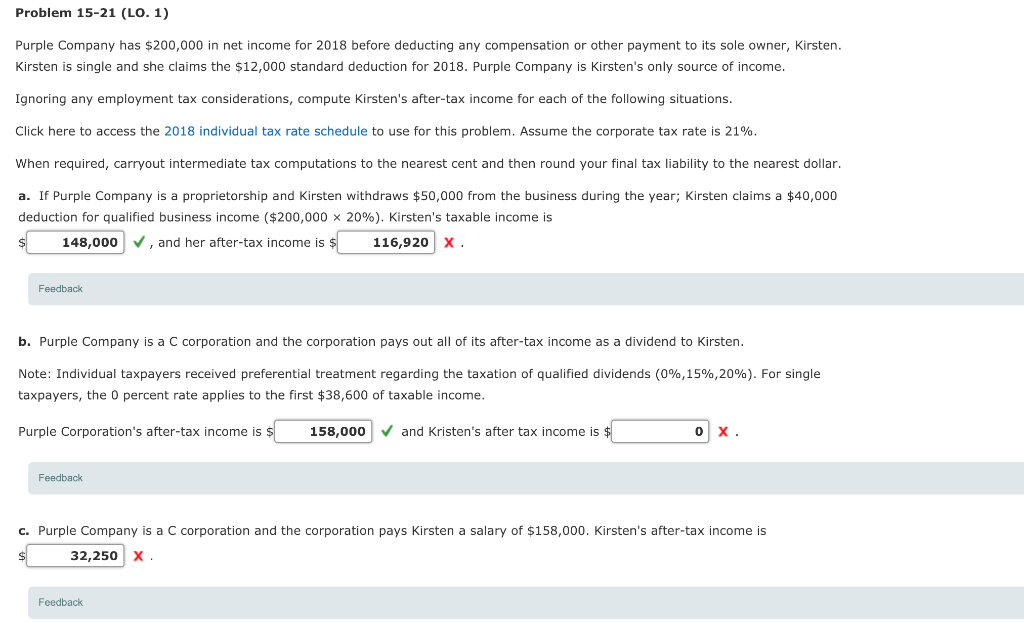
Problem 15-21 (LO. 1) Purple Company has $200,000 in net income for 2018 before deducting any compensation or other payment to its sole owner, Kirsten. Kirsten is single and she claims the $12,000 standard deduction for 2018. Purple Company is Kirsten's only source of income. Ignoring any employment tax considerations, compute Kirsten's after-tax income for each of the following situations. Click here to access the 2018 individual tax rate schedule to use for this problem. Assume the corporate tax rate is 21%. When required, carryout intermediate tax computations to the nearest cent and then round your final tax liability to the nearest dollar a. If Purple Company is a proprietorship and Kirsten withdraws $50,000 from the business during the year; Kirsten claims a $40,000 deduction for qualified business income ($200,000 2096), Kirsten's taxable income is 148,000, and her after-tax income is 116,920 Feedback b. Purple Company is a C corporation and the corporation pays out all of its after-tax income as a dividend to Kirsten Note: Individual taxpayers received preferential treatment regarding the taxation of qualified dividends 0% 15% 20% taxpayers, the 0 percent rate applies to the first $38,600 of taxable income. for single Purple Corporation's after-tax income is s158,00oand Kristen's after tax income is Feedback c. Purple Company is a C corporation and the corporation pays Kirsten a salary of $158,000. Kirsten's after-tax income is 32,250X Feedback Problem 15-21 (LO. 1) Purple Company has $200,000 in net income for 2018 before deducting any compensation or other payment to its sole owner, Kirsten. Kirsten is single and she claims the $12,000 standard deduction for 2018. Purple Company is Kirsten's only source of income. Ignoring any employment tax considerations, compute Kirsten's after-tax income for each of the following situations. Click here to access the 2018 individual tax rate schedule to use for this problem. Assume the corporate tax rate is 21%. When required, carryout intermediate tax computations to the nearest cent and then round your final tax liability to the nearest dollar a. If Purple Company is a proprietorship and Kirsten withdraws $50,000 from the business during the year; Kirsten claims a $40,000 deduction for qualified business income ($200,000 2096), Kirsten's taxable income is 148,000, and her after-tax income is 116,920 Feedback b. Purple Company is a C corporation and the corporation pays out all of its after-tax income as a dividend to Kirsten Note: Individual taxpayers received preferential treatment regarding the taxation of qualified dividends 0% 15% 20% taxpayers, the 0 percent rate applies to the first $38,600 of taxable income. for single Purple Corporation's after-tax income is s158,00oand Kristen's after tax income is Feedback c. Purple Company is a C corporation and the corporation pays Kirsten a salary of $158,000. Kirsten's after-tax income is 32,250X Feedback







